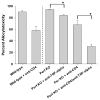Cytotoxic effector function of CD4-independent, CD8(+) T cells is mediated by TNF-α/TNFR
- PMID: 23222736
- PMCID: PMC3522862
- DOI: 10.1097/TP.0b013e318270f3c0
Cytotoxic effector function of CD4-independent, CD8(+) T cells is mediated by TNF-α/TNFR
Abstract
Background: Liver parenchymal cell allografts initiate both CD4-dependent and CD4-independent, CD8(+) T cell-mediated acute rejection pathways. The magnitude of allospecific CD8(+) T cell in vivo cytotoxic effector function is maximal when primed in the presence of CD4(+) T cells. The current studies were conducted to determine if and how CD4(+) T cells might influence cytotoxic effector mechanisms.
Methods: Mice were transplanted with allogeneic hepatocytes. In vivo cytotoxicity assays and various gene-deficient recipient mice and target cells were used to determine the development of Fas-, TNF-α-, and perforin-dependent cytotoxic effector mechanisms after transplantation.
Results: CD8(+) T cells maturing in CD4-sufficient hepatocyte recipients develop multiple (Fas-, TNF-α-, and perforin-mediated) cytotoxic mechanisms. However, CD8(+) T cells, maturing in the absence of CD4(+) T cells, mediate cytotoxicity and transplant rejection that is exclusively TNF-α/TNFR-dependent. To determine the kinetics of CD4-mediated help, CD4(+) T cells were adoptively transferred into CD4-deficient mice at various times posttransplant. The maximal influence of CD4(+) T cells on the magnitude of CD8-mediated in vivo allocytotoxicityf occurs within 48 hours.
Conclusion: The implication of these studies is that interference of CD4(+) T cell function by disease or immunotherapy will have downstream consequences on both the magnitude of allocytotoxicity as well as the cytotoxic effector mechanisms used by allospecific CD8(+) cytolytic T cells.
Conflict of interest statement
The authors of this manuscript have no conflicts of interest to disclose.
Figures






Similar articles
-
Disparate primary and secondary allospecific CD8+ T cell cytolytic effector function in the presence or absence of host CD4+ T cells.J Immunol. 2007 Jul 1;179(1):80-8. doi: 10.4049/jimmunol.179.1.80. J Immunol. 2007. PMID: 17579024
-
Antigen-primed CD8+ T cells can mediate resistance, preventing allogeneic marrow engraftment in the simultaneous absence of perforin-, CD95L-, TNFR1-, and TRAIL-dependent killing.Blood. 2003 May 15;101(10):3991-9. doi: 10.1182/blood-2002-09-2859. Epub 2003 Jan 9. Blood. 2003. PMID: 12521999
-
Virally infected hepatocytes are resistant to perforin-dependent CTL effector mechanisms.J Immunol. 2001 Aug 1;167(3):1566-74. doi: 10.4049/jimmunol.167.3.1566. J Immunol. 2001. PMID: 11466378
-
Cytotoxic CD4+ T cells in cancer: Expanding the immune effector toolbox.Immunity. 2021 Dec 14;54(12):2701-2711. doi: 10.1016/j.immuni.2021.11.015. Immunity. 2021. PMID: 34910940 Free PMC article. Review.
-
CD4 T-cell immunotherapy for chronic viral infections and cancer.Immunotherapy. 2013 Sep;5(9):975-87. doi: 10.2217/imt.13.91. Immunotherapy. 2013. PMID: 23998732 Free PMC article. Review.
Cited by
-
TFNR2 in Ischemia-Reperfusion Injury, Rejection, and Tolerance in Transplantation.Front Immunol. 2022 Jul 7;13:903913. doi: 10.3389/fimmu.2022.903913. eCollection 2022. Front Immunol. 2022. PMID: 35874723 Free PMC article. Review.
-
Alloprimed CD8(+) T cells regulate alloantibody and eliminate alloprimed B cells through perforin- and FasL-dependent mechanisms.Am J Transplant. 2014 Feb;14(2):295-304. doi: 10.1111/ajt.12565. Am J Transplant. 2014. PMID: 24472191 Free PMC article.
-
HLA-A2, HLA-B44 and HLA-DR15 are associated with lower risk of BK viremia.Nephrol Dial Transplant. 2013 Dec;28(12):3119-26. doi: 10.1093/ndt/gft298. Epub 2013 Sep 30. Nephrol Dial Transplant. 2013. PMID: 24084328 Free PMC article.
-
Soluble TNF-alpha-receptors I are prognostic markers in TIPS-treated patients with cirrhosis and portal hypertension.PLoS One. 2013 Dec 26;8(12):e83341. doi: 10.1371/journal.pone.0083341. eCollection 2013. PLoS One. 2013. PMID: 24386183 Free PMC article.
-
Critical Role of Macrophage FcγR Signaling and Reactive Oxygen Species in Alloantibody-Mediated Hepatocyte Rejection.J Immunol. 2018 Dec 15;201(12):3731-3740. doi: 10.4049/jimmunol.1800333. Epub 2018 Nov 5. J Immunol. 2018. PMID: 30397035 Free PMC article.
References
-
- Barber DL, Wherry EJ, Ahmed R. Cutting edge: rapid in vivo killing by memory CD8 T cells. J Immunol. 2003;171 (1):27. - PubMed
-
- Halloran PF, Urmson J, Ramassar V, et al. Lesions of T-cell-mediated kidney allograft rejection in mice do not require perforin or granzymes A and B. Am J Transplant. 2004;4 (5):705. - PubMed
-
- O’Connell PJ, Pacheco-Silva A, Nickerson PW, et al. Unmodified pancreatic islet allograft rejection results in the preferential expression of certain T cell activation transcripts. J Immunol. 1993;150 (3):1093. - PubMed
-
- Han D, Xu X, Baidal D, et al. Assessment of cytotoxic lymphocyte gene expression in the peripheral blood of human islet allograft recipients: elevation precedes clinical evidence of rejection. Diabetes. 2004;53 (9):2281. - PubMed
Publication types
MeSH terms
Substances
Grants and funding
LinkOut - more resources
Full Text Sources
Medical
Research Materials
Miscellaneous

